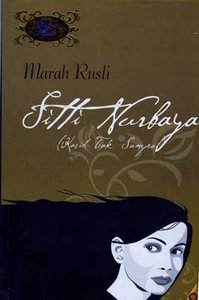
Chairil Anwar was an Indonesian poet and member of the "1945 Generation" of writers. He is estimated to have written 96 works, including 70 individual poems.

Indonesian literature is a term grouping various genres of South-East Asian literature.
Balai Pustaka is the state-owned publisher of Indonesia and publisher of major pieces of Indonesian literature such as Salah Asuhan, Sitti Nurbaya and Layar Terkembang. Its head office is in Jakarta.

Jalan Tak Ada Ujung is an Indonesian novel by Mochtar Lubis first published by Balai Pustaka in 1952. It takes place during the Indonesian war of independence and tells the story of Guru Isa, a schoolteacher who assists the guerrilla freedom fighters yet lives in fear.

Sitti Nurbaya: Kasih Tak Sampai is an Indonesian novel by Marah Rusli. It was published by Balai Pustaka, the state-owned publisher and literary bureau of the Dutch East Indies, in 1922. The author was influenced by the cultures of the west Sumatran Minangkabau and the Dutch colonials, who had controlled Indonesia in various forms since the 17th century. Another influence may have been a negative experience within the author's family; after he had chosen a Sundanese woman to be his wife, Rusli's family brought him back to Padang and forced him to marry a Minangkabau woman chosen for him.

Armijn Pane, also known as Adinata, A. Soul, Empe, A. Mada, A. Banner, and Kartono, was an Indonesian author.

Tengku Amir Hamzah was an Indonesian poet and National Hero of Indonesia. Born into a Malay aristocratic family in the Sultanate of Langkat in North Sumatra, he was educated in both Sumatra and Java. While attending senior high school in Surakarta around 1930, Amir became involved with the nationalist movement and fell in love with a Javanese schoolmate, Ilik Sundari. Even after Amir continued his studies in legal school in Batavia the two remained close, only separating in 1937 when Amir was recalled to Sumatra to marry the sultan's daughter and take on responsibilities of the court. Though unhappy with his marriage, he fulfilled his courtly duties. After Indonesia proclaimed its independence in 1945, he served as the government's representative in Langkat. The following year he was killed in a social revolution led by the PESINDO, and buried in a mass grave.

Belenggoe is a novel by Indonesian author Armijn Pane. The novel follows the love triangle between a doctor, his wife, and his childhood friend, which eventually causes each of the three characters to lose the ones they love. Originally published by the literary magazine Poedjangga Baroe in three instalments from April to June 1940, it was the magazine's only published novel. It was also the first Indonesian psychological novel.

Poedjangga Baroe was an Indonesian avant-garde literary magazine published from July 1933 to February 1942. It was founded by Armijn Pane, Amir Hamzah, and Sutan Takdir Alisjahbana.

Sanusi Pane was an Indonesian writer, journalist, and historian. He was highly active in literary media, sitting on the editorial boards of several publications. He has also been described as the most important dramatist from before the Indonesian National Revolution.

Atheis is a 1949 Indonesian novel written by Achdiat Karta Mihardja and published by Balai Pustaka. The novel, using three narrative voices, details the rise and fall of Hasan, a young Muslim who is raised to be religious but winds up doubting his faith after dealings with his Marxist–Leninist childhood friend and an anarcho-nihilist writer.
Darah Muda is a 1927 novel written by Indonesian writer Djamaluddin Adinegoro and published by Balai Pustaka. It is one of few Indonesian novels from the period in which the protagonists succeed in love.

Muhammad Salim Balfas, better known as M. Balfas, was an Indonesian writer and literary critic.
Asmara Djaja is a 1928 novel written by Indonesian writer Djamaluddin Adinegoro and published by Balai Pustaka. It is one of few Indonesian novels from the period in which the protagonists succeed in love.
"Soerabaja" is a work of fiction by Indonesian writer Idrus variously described as a novel, novelette, and long short story. It was published in 1946 or 1947.

Zuber Usman was an Indonesian teacher and writer, known as an early pioneer of Indonesian literary criticism. Born in Padang, West Sumatra, he was educated in Islamic schools until 1937, after which he became a teacher. Dabbling in writing short stories during the Japanese occupation of the Dutch East Indies and the ensuing revolution, for the rest of his life Usman focused on teaching and writing about literature.

Indonesian author Amir Hamzah (1911–1946) wrote 50 poems, 18 pieces of lyrical prose, 12 articles, 4 short stories, 3 poetry collections, and 1 book. He also translated 44 poems, 1 piece of lyrical prose, and 1 book. The majority of Amir's original poems are included in his collections Njanji Soenji (1937) and Boeah Rindoe (1941), both first published in the literary magazine Poedjangga Baroe. His translated poems were collected in Setanggi Timoer (1939). In 1962 documentarian HB Jassin compiled all of Amir's remaining works – except the book Sastera Melajoe Lama dan Radja-Radja'nja – as Amir Hamzah: Radja Penjair Pudjangga Baru.

Njanji Soenji is a 1937 poetry collection by Amir Hamzah. Written some time after the poet was forced to marry the daughter of the Sultan of Langkat instead of his chosen love in Java, this collection consists of 24 titled poems and pieces of lyrical prose, none of which are dated. First published in the magazine Poedjangga Baroe, the collection has been republished as a stand-alone book several times.
The Dutch-Indonesian foundation Stichting Opbouw-Pembangoenan was established on 24 March 1947 by the Dutch weekly Vrij Nederland. The foundation had a mixed Dutch-Indonesian board and ran bookstores and a publishing house.














